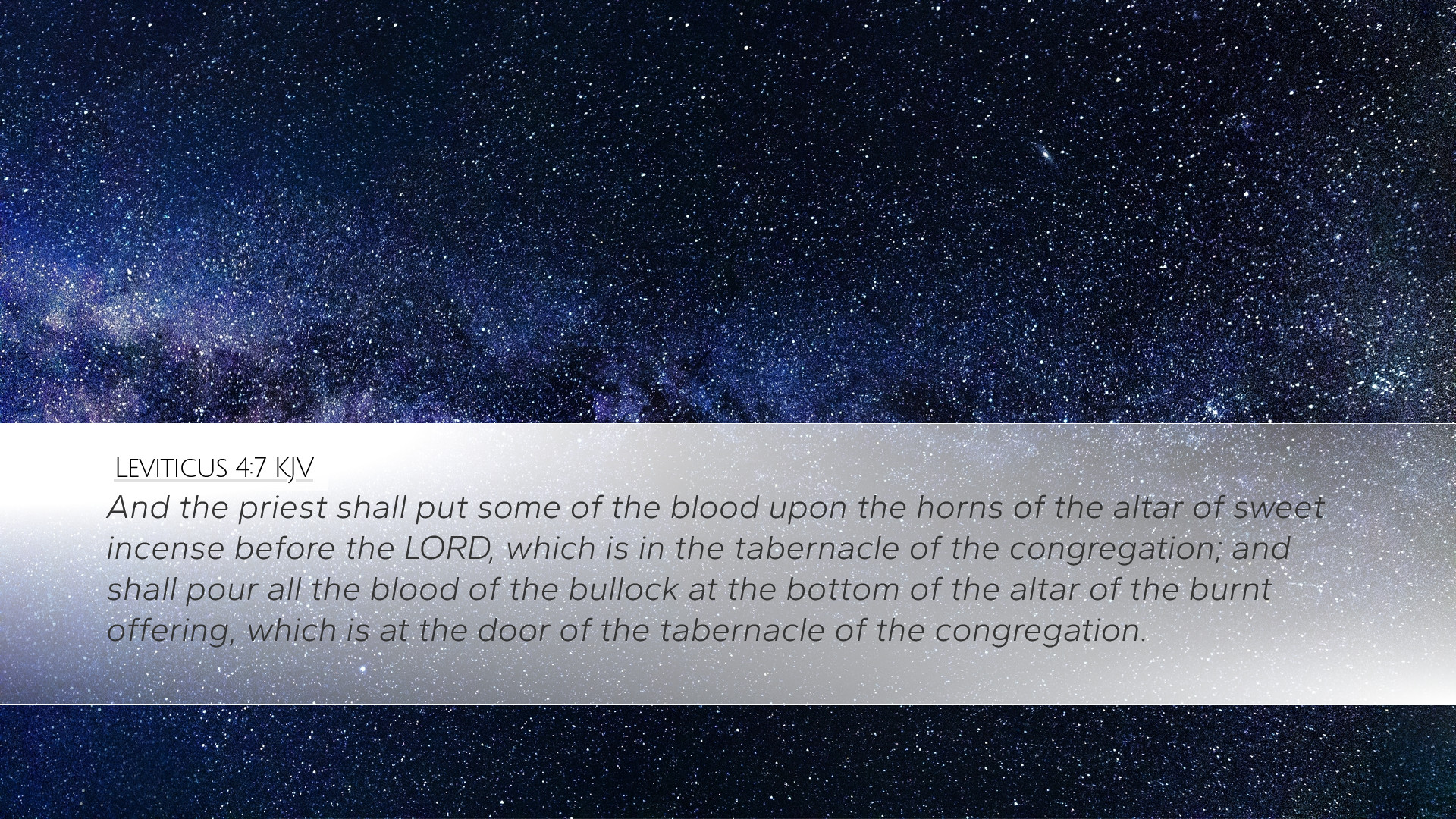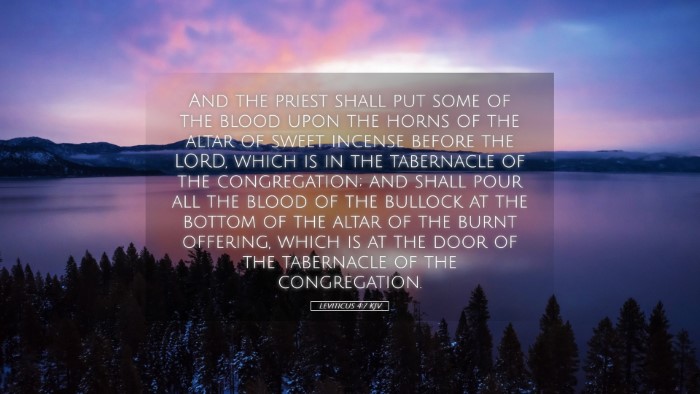Commentary on Leviticus 4:7
Verse: "And the priest shall take the blood of the sin offering with his finger, and put it upon the horns of the altar of burnt offering, and shall pour out his blood at the bottom of the altar of burnt offering." (Leviticus 4:7)
Introduction
The book of Leviticus is often seen as a manual for the priests and Levites of Israel, detailing the rituals, offerings, and laws meant to guide the religious life of the Israelites. Leviticus 4 specifically addresses the sin offering, a key component in the system of sacrifices provided by God to address the issue of sin among His people.
This verse serves as a pivotal moment in the sin offering ritual, emphasizing the roles of the priest in relation to atonement, the symbolism of blood, and the necessity of sacrifice for restoring fellowship with God.
The Role of the Priest
In their comments, Matthew Henry highlights the significant responsibility of the priest in the sacrificial system. The priest acts as an intermediary between God and the people, signifying the need for a mediator in dealing with sin.
Albert Barnes elaborates that the priest's actions are detailed in their importance, with the taking of blood being both a physical act and a representation of spiritual truth. The priest's role is essential not just for the procedure of sacrifice but also for conveying the seriousness of sin and the necessity of atonement and forgiveness.
Adam Clarke notes that the involvement of the priest emphasizes the holiness of the sacrificial process and the structured nature of worship in Israel. The priest's actions embody the careful obedience that God requires in approaching Him, reflecting the gravity of sin and the seriousness of atonement.
The Significance of Blood
The blood, as mentioned in this verse, is the central element of the sin offering. Matthew Henry refers to the blood as the life force, underlining its vital significance in both ancient sacrifices and in the broader biblical narrative of atonement.
Albert Barnes emphasizes that the use of blood signifies the life being offered to God as a symbol of repentance and a plea for forgiveness. Blood represents both death and life; thus, its application to the altar symbolizes the death that sin incurs and the life that is restored through God's mercy.
Adam Clarke elaborates that this ritual will be seen as a foreshadowing of the ultimate sacrifice of Christ, where His blood would be the final act of atonement. The pouring out of blood at the altar indicates a profound connection to the concept of sacrifice for sin that culminates in the New Testament with Christ’s crucifixion.
The Altar of Burnt Offering
The location of the blood application—upon the horns of the altar of burnt offering and at its base—holds deep significance. Matthew Henry notes that the altar represents the place of atonement and is the meeting point between God and humanity. The placement of blood on the altar accentuates God’s provision for sin-offering and reconciling humanity to Himself.
Albert Barnes emphasizes that the horns of the altar were considered places of refuge. It symbolizes the security and the assurance that forgiveness is available to the sinner who comes in faith to atone for sins.
Adam Clarke ties this to the sacrificial system as a whole, elucidating the comprehensive nature of Israel’s worship. The movement and application of blood was not merely a procedural act but also an active demonstration of God’s mercy and grace granted to sinners.
The Theological Implications
The theological ramifications of Leviticus 4:7 are immensely profound. Matthew Henry expresses that this act signifies not only the gravity of sin but also God's willingness to forgive. The ritual highlights God's desire for relationship rather than mere compliance to laws.
Albert Barnes relates this passage to the New Covenant, arguing that the sacrificial system establishes the foundation for understanding Christ’s sacrifice as the fulfillment of the law. The significance of blood in atonement is echoed throughout the scriptures, culminating in the New Testament.
Adam Clarke warns against the danger of ritualism devoid of heartfelt repentance. He elaborates that while rituals are integral to worship, the genuine return to God requires true contrition and a heart aligned with His will. This verse serves as a reminder of both the cost of sin and the depth of God’s love.
Conclusion
Leviticus 4:7 provides rich insights into the practice of sin offerings and their implications for worship, sin, and redemption. By combining the observations of esteemed commentators like Matthew Henry, Albert Barnes, and Adam Clarke, we see a multifaceted understanding of the significance of this verse. Understanding the role of the priest, the significance of the blood, the action at the altar, and the overarching theological implications allows for a deeper comprehension of the sacrificial system and its culmination in Christ’s redeeming work.
For pastors, students, theologians, and Bible scholars, insight into this verse serves as a critical reminder of the continuing narrative of sin and redemption that runs throughout Scripture and the call to approach God with humility, faith, and repentance.


